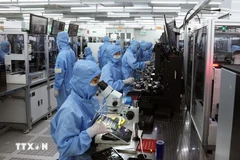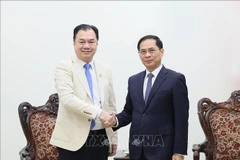However, the industry would face many challenges in reaching thistarget, in particular a lack of material, capital and technology.
Experts said that the industry should assert more control over thelicensing of paper factories and should manage investments moreefficiently during the plan's implementation over the next decade.
The Vietnam Paper and Pulp Association reported that the industry wouldrequire 95.6 trillion VND (4.57 billion USD) during the period from2006-20, including 87.7 trillion VND (4.2 billion USD) for new factoriesand 7.9 trillion VND (370 million USD) for the development ofpaper-producing forest.
The investment would supply 600,000 tonnes of pulp in 2010 and 1.8 million tonnes of pulp in 2020.
However, during the 2006-11 period, many paper production projects wereoperated inefficiently and had negatively affected the environment,causing the development plan to stall, the association said.
Nguyen Kim Hue, head of the Information Technology Department at theCellulose and Paper Industry Institute, said pulp factories lacked woodduring the 2006-11 period because forest growers had not offered theirproduct at a reasonable rate.
Banks have been scepticalabout the competitive ability of the industry, and have been reluctantto provide it with loans. Only two of eight paper projects developed in2010 have progressed according to schedule.
Phan Chi Dung,head of the Light Industry Department under the Ministry of Industryand Trade, said Vietnam has 500 paper producers but almost all ofthem are small- and medium-sized enterprises using old technology.
But the new development plan has not fixed specific standards toimprove the quality and efficiency of production, he said, nor does itprovide guidelines for waste treatment.
Dung said onepossibility would be to withhold licenses from certain productionfacilities to ensure the sustainable development of the industry. Theplan would be capped at a total capacity of 250,000-400,000 tonnes ofpulp per year.
Pham Van Tu, representative of the VietnamPaper Corporation, said pulp production factories should not be sitedfar upstream along rivers to avoid pollution of environment.
All previous development plants had failed and a management team wasurgently needed to ensure the implementation of the plan, said Tu,adding that the provinces should grant licences for pulp and paperfactories according to the regulations approved by the Government.
At present, average paper consumption world-wide was 4 kilos per personper year, while the average for Vietnamese was around 1 kilo. Ignoringenvironmental concerns, Vietnam has the potential to expand itspaper market in the future but the industry would need support from theState, said the association.
The State should stabilisetax policy for the paper industry according to World Trade Organisation(WTO) guidelines, said the association. It should also introduceregulations on limiting the use of detergents in paper production.
Vu Ngoc Bao, general secretary of the association, said the Stateshould call on foreign investment to upgrade the processing of pulp andpaper production technology.
The State should createfavourable conditions for the industry to accumulate capital and createincentives for enterprises and households to develop new seeds in orderto improve output, quality and competitiveness of pulp, Bao said. /.
























